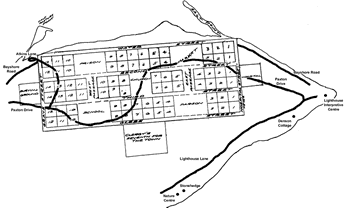|
In
the first half of the 18th century, North America
included British colonies along the Atlantic coast
from Massachusetts to the Carolinas, as well as the
French colony, New France. A war broke out between
Britain and France in 1755. The British general, Wolfe,
defeated, the French general Montcalm on the Plains
of Abraham located outside Quebec City on September
13, 1759. The Treaty of Paris (1763) ended the war
and recognized British control of the colony of Canada.
The colony consisted of New France (Quebec) and the
current area of Ontario, composed mainly of a few
trading posts at that time.
In
1774, the Revolutionary War broke out as the British
colonies along the Atlantic coast fought for their
independence. Many of the residents remained loyal
to the British and fought against the revolutionary
army. However, the Americans won their independence.
The treaty signed between Britain and America in 1783,
also called the Treaty of Paris, established the boundary
between Canada and the United States as being the
centre of the Great Lakes and connecting rivers.
Some
35,000 to 40,000 Loyalists came to Canada after the
war. Most of these Loyalists immigrated to the Maritimes
or to the eastern townships of Quebec. However, some
came to Ontario and by 1791, there were some 15,000
Loyalists in Ontario.
The
Constitution Act of 1791 divided the British colony,
Canada, into two provinces, Lower Canada, now Quebec,
and Upper Canada, now Ontario. Additional settlers
came from Britain and the United States, until by
1812, there were about 80,000 people in Upper Canada.
John Graves Simcoe was the first Lieutenant Governor
of Upper Canada. Its capital, initially at Niagara-on-the-Lake,
was moved in 1794 to York, now Toronto.
In
1796, it was decided that Upper Canada be divided
into districts. York was to be the capital of the
Home District, which included York, Peel, Simcoe,
Durham and Northumberland counties. An Act of Parliament
indicated that when the counties of Durham and Northumberland
contained 1000 residents, those counties would be
made into a separate district named Newcastle. The
district capital, also to be named Newcastle, was
to be located on the Presqu'ile peninsula, which had
the first natural harbour on Lake Ontario east of
York. In 1797, the Deputy Surveyor General, Alexander
Aitkin, completed the survey of Newcastle and laid
out the lots and roads as shown on the plan.
|

Proposed plan of Newcastle (Includes
current landmarks)
Click on map for larger image
In
1802, the District of Newcastle was officially approved
and a courthouse and jail were built. Both facilities
were housed in a large frame building about 50 feet
long, 30 feet wide and three stories high. It was
placed in the care of a Captain Selleck, who moved
in with his family. One-acre lots were also granted
to Timothy Thompson, Thomas Ward, Joseph Gibson, and
David Rogers.
The
first trial in the courthouse was scheduled for 1804.
A native man charged with the murder of a trading
post operator on Lake Scugog, was to be the first
person tried in this court. He was being transported
from York to Newcastle with a number of prominent
citizens aboard the Speedy. On the night of Oct. 8,
1804, the ship was lost with all aboard, just off
Presqu'ile.
Due
to the seemingly "inconvenient" location
of the town of Newcastle and the pleas of its residents,
an Act of Parliament passed on March 2, 1805 transferred
the district capital to another location. A new courthouse
was built in Hamilton Township and the settlement
that grew around it was called Amherst (now Cobourg.)
The
Newcastle courthouse was sold to Captain Selleck.
The third floor was removed and the building was used
as the family home for many years. The home has been
gone for more than a century, and, though efforts
have been made to find it, the original location is
still unknown today. It was probably built in the
area designated 'prison' on the town plan. Further
efforts will be made to find the location of this
home, the only government building ever completed
in the original town of Newcastle.
Newcastle
By Harold Atkins
Return
to the top of the page
|